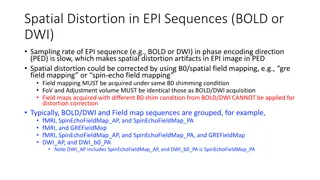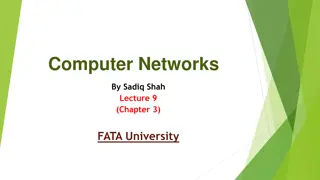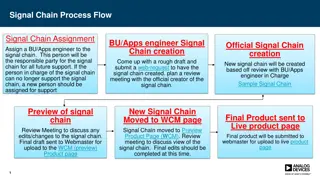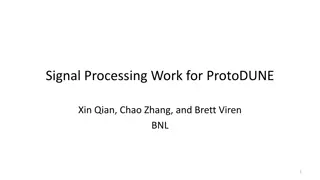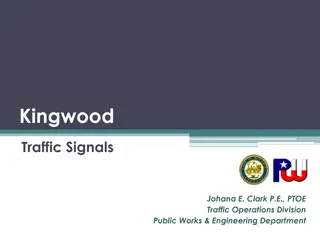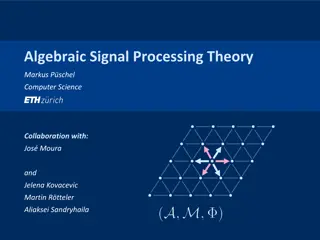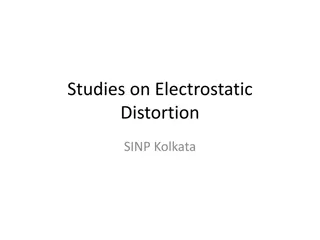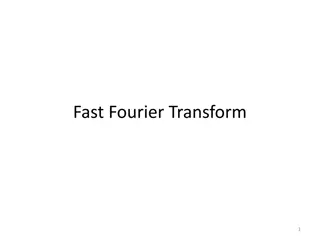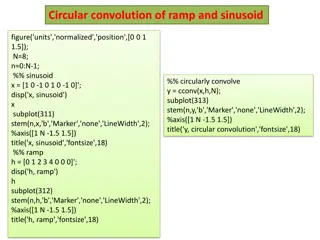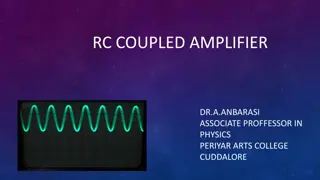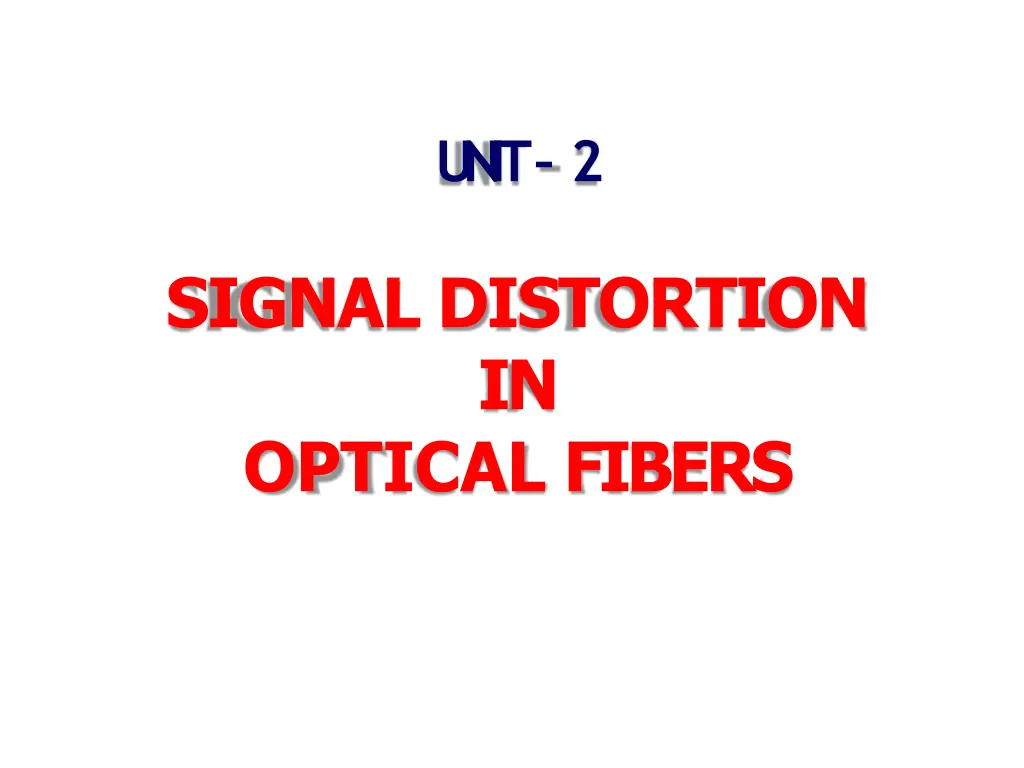
Understanding Signal Distortion in Optical Fibers
Learn about the importance of signal attenuation and distortion in optical fibers, their impact on signal quality, factors causing attenuation, absorption losses, attenuation units, and wavelength dependency. Discover how these properties affect the performance and reliability of optical fiber communication systems.
Download Presentation

Please find below an Image/Link to download the presentation.
The content on the website is provided AS IS for your information and personal use only. It may not be sold, licensed, or shared on other websites without obtaining consent from the author. If you encounter any issues during the download, it is possible that the publisher has removed the file from their server.
You are allowed to download the files provided on this website for personal or commercial use, subject to the condition that they are used lawfully. All files are the property of their respective owners.
The content on the website is provided AS IS for your information and personal use only. It may not be sold, licensed, or shared on other websites without obtaining consent from the author.
E N D
Presentation Transcript
UNIT 2 SIGNAL DISTORTION IN OPTICAL FIBERS
Introduction One of the important property of optical fiber is signal attenuation. It is also known as fiber loss or signal loss. The signal attenuation of fiber determines the maximum distance between transmitter and receiver. The attenuation also determines the number of repeaters required, maintaining repeater is a costly affair. Another important property of optical fiber is distortion mechanism. As the signal pulse travels along the fiber length it becomes more broader. After sufficient length the broad pulses starts overlapping with adjacent pulses. This creates error in the receiver. Hence the distortion limits the information carrying capacity of fiber.
Attenuation Attenuation is a measure of decay of signal strength or loss of light power that occurs as light pulses propagate through the length of the fiber. In optical fibers the attenuation is mainly caused by two physical factors absorption and scattering losses. Absorption is because of fiber material and scattering due to structural imperfection within the fiber. Nearly 90 % of total attenuation is caused by Rayleigh scattering only. Micro bending of optical fiber also contributes to the attenuation of signal. The rate at which light is absorbed is dependent on the wavelength of the light and the characteristics of particular glass. Glass is a silicon compound, by adding different additional chemicals to the basic silicon dioxide the optical properties of the glass can be changed. The Rayleigh scattering is wavelength dependent and reduces rapidly as the wavelength of the incident radiation increases. The attenuation of fiber is governed by the materials from which it is fabricated, the manufacturing process and the refractive index profile chosen. Attenuation loss is measured in dB/km.
Attenuation Units As attenuation leads to a loss of power along the fiber, the output power is significantly less than the couples power. Let the couples optical power is p(0) i.e. at origin (z = 0). Then the power at distance z is given by, P(z) = P(0)e pZ Where p is the fiber attenuation constant (per km) =1ln P(0) P(Z ) z P P(0) P(Z ) 1 z = 10. .log (d B / km ) This parameter is known as Fiber loss or Fiber Attenuation
Attenuation is also a function of wavelength. Optical fiber wavelength as a function of wavelength is shown in Fig
Absorption Absorption loss is related to the material composition and fabrication process of fiber. Absorption loss results in dissipation of some optical power as heat in the fiber cable. Although glass fibers are extremely pure, some impurities still remain as residue after purification. The amount of absorption by these impurities depends on their concentration and light wavelength. Absorption is caused by three different mechanisms: 1) Absorption by atomic defects in glass composition. 2) Extrinsic absorptionby impurity atoms in glass mats. 3) Intrinsicabsorption by basicconstituent atom of fiber.
Absorptionby Atomic Defects Atomic defects are imperfections in the atomic structure of the fiber materials such as missing molecules, high density clusters of atom groups. These Absorption losses are negligible compared with intrinsic and extrinsic losses. The absorption effect is most significant when fiber is exposed to ionizing radiation in nuclear reactor, medical therapies, space missions etc. The radiation damages the internal structure of fiber. The damages are proportional to the intensity of ionizing particles. This results in increasing attenuation due to atomic defects and absorbing optical energy.
rad (Si), this is the unit for measuring radiation absorbed in bulk silicon
ExtrinsicAbsorption Extrinsic absorption occurs due to electronic transitions between the energy level and because of charge transitions from one ion to another. A major source of attenuation is from transition of metal impurity ions such as iron, chromium, cobalt and copper. These losses can be up to 1 to 10 dB/km. The effect of metallic impurities can be reduced by glass refining techniques. Another Major Extrinsic loss is caused by absorption due to OH (Hydroxil) ions impurities dissolved in glass. Vibrations occur at wavelengths between 2.7 and 4.2 m. The absorption peaks occurs at 1400, 950 and 750 nm. These are first, second and third overtones respectively.
Intrinsic Absorption Intrinsic absorption occurs when material is in absolutely pure state, no density variation and inhomogenities. Thus intrinsic absorption sets the fundamental lower limit on absorption for any particular material. Intrinsic Absorption Results from Electronic absorption Bands in UV Region and from atomic vibration bands in the near infraredregion. The electronic absorption bands are associated with the band gaps of amorphous glass materials. Absorption occurs when a photon interacts with an electron in the valence band and excites it to a Higher Energy level. UV absorption Decays Exponentially With increasingwavelength ( ).
In the IR (infrared) region above 1.2 m the optical waveguide loss is determined by presence of the OH ions and inherent IR absorption of the constituent materials. The inherent IR absorption is due to interaction between the vibrating band and the electromagnetic field of optical signal this results in transfer of energy from field to the band, thereby giving rise to absorption, this absorption is strong because of many bonds present in the fiber.
The ultraviolet loss at any wavelength is expressed as, Where, x is mole fraction of GeO2. is operating wavelength uvis in dB/km The loss in infrared (IR) region (above 1.2 m) is given by expression : The expression is derived for GeO2 SiO2glass fiber.
ScatteringLosses Scattering losses exists in optical fibers because of microscopic variations in the material density and composition. As glass is composed by randomly connected network of molecules and several oxides (e.g. SiO2, GeO2 and P2O5), these are the major cause of compositional structure fluctuation. These two effects results to variation in refractive index and Rayleigh type scattering of light. There are two types of Scattering: 1. Rayleigh Scattering 2. MIE Scattering
RayleighScattering Losses Rayleigh scattering of light is due to small localized changes in the refractive index of the core and cladding material. There are two causes during the manufacturing of fiber. The first is due to Slight fluctuation in mixing of ingredients. The Random changes because of this are impossible to eliminate completely. The other cause is slight change in density as the silica cools and solidifies. When light ray strikes such zones it gets scattered in all directions. The amount of scatter depends on the size of the discontinuity compared with the wavelength of the light so the shortest wavelength (highest frequency) suffers most scattering. Fig. shows graphically the relationship between wavelength and Rayleigh scattering loss.
Scattering loss for single component glass is given by, Where, n = Refractive index k = Boltzmann's constant T= Isothermal compressibility of material Tf= Temperature at which density fluctuations are frozen into the glass as it solidifies (fictive temperature)
Another form of equation is where, p = Photo elasticcoefficient Scattering loss for multi component glasses is given by, where, 2n= Mean square refractive index fluctuation v= Volume of fiber Multimode fibers have higher dopant concentrations and greater compositional fluctuations. The overall losses in this fibers are more as compared to single mode fibers.
MIEScattering Linear scattering also occurs at inhomogenities and these arise from imperfections in the fibre's geometry, irregularities in the refractive index and the presence of bubbles etc. caused during manufacture. Careful control of manufacturing process can reduce MIE scattering to insignificant levels. Fig. Linear Scattering
BendingLosses The loss which exists when an optical fiber undergoes bending is called bending loss. Losses due to curvature and losses caused by an abrupt change in radius of curvature are referred to as bending losses. The sharp bend of a fiber causes significant radiative losses and there is also possibility of mechanical failure.This is shown in Fig. As the core bends, the normal will follow it and the ray will now find itself on the wrong side of critical angle and will escape. The sharp bends are therefore avoided.
The radiation loss from a bent fiber depends on: - Field strength where power is lost through radiation. - The radius of curvature R. The higher order modes are less tightly bound to the fiber core, the higher order modes radiate out of fiber firstly. For multimode fiber, the effective number of modes that can be guided by curvedfiber is given expression : where, is graded index profile. difference. n2 is refractive index of cladding. is core cladding index k is wave propagationconstant .
N is total number of modes in a straight fiber. (n K a) 2 = N + 2 1 Bending the fiber also causes attenuation. Bending loss is classified according to the bend radius of curvature: Microbend loss or Macrobend loss.
Macrobend losses : Bending in which complete fiber undergoes bends which causes certain modes not to be reflected . These losses are observed when a fiber bend's radius of curvature is large compared to the fiber diameter. Fiber sensitivity to bending losses can be reduced. If the refractive index of the core is increased, then fiber sensitivity decreases. Sensitivity also decreases as the diameter of the overall fiber increases. However, increases in the fiber core diameter increase fiber sensitivity. Fibers with larger core size propagate more modes. These additional modes tend to be more lossy. For loss is extremely and is not observed. slight bends, the small
Microbending: This is a loss due to small bending or distortions. This small microbending is not visible. The losses due to this are temperature related, tensile related or crush related. The effects of microbending on multimode fiber can result in increasing attenuation. These effects can be minimized during installation and testing.
Core & Cladding Losses Since the core and cladding have different indices of refraction hence they have different attenuation coefficients 1 and 2 respectively. For step index fiber,the loss for a mode order (v,m) is given by, For low-order modes, the expression reduced to where Pcore/P and Pcladding/P are fractional powers
For graded index fiber, loss at radial distance is expressed as, The loss for a given mode is expressed by, where, P(r) is power density of that model at radial distance r.
Signal Distortion in Optical Waveguide The pulse get distorted as it travels along the fiber lengths. Pulse spreading in fiber is referred as dispersion. Dispersion is caused by difference in the propagation times of light rays that takes different paths during the propagation. The light pulses travelling down the fiber encounter dispersion effect because of this the pulse spreads out in time domain. Dispersion limits the information bandwidth. The distortion effects can be analyzed by studying the group velocities in guided modes. Information Capacity Determination Dispersion and attenuation of pulse travelling along the fiber is shown in Fig
Fig. shows, after travelling some distance, pulse starts broadening and overlap with the neighbouring pulses. At certain distance the pulses are not even distinguishable and error will occur at receiver. Therefore the information capacity is specified by bandwidth- distance product (MHz . km). For step index bandwidth distance product is 20 MHz . km and for graded index it is 2.5 MHz . km.
GroupDelay Consider a fiber cable carrying optical signal equally with various modes and each mode contains all the spectral components in the wavelength band. All the spectral components travel independently and they observe different time delay and group delay in the direction of propagation. The velocity at which the energy in a pulse travels along the fiber is known as group velocity. Group velocity is given by, = V g Thus different frequency components in a signal will travel at different group velocities and so will arrive at their destination at different times, for digital modulation of carrier, this results in dispersion of pulse, which affects the maximum rate of modulation.
Let the difference in propagationtimes for two side bands is . t =d . d Derivation is here
Dispersion in Optical Fiber In communication, dispersion is used to describe any process by which any electromagnetic signal propagating in a physical medium is degraded because the various wave characteristics (i.e., frequencies) of the signal have different propagationvelocities within the physical medium. The pulse gets distorted as it travels along the fiber lengths. Pulse spreading in fiber is referred as dispersion. Dispersion is caused by difference in the propagation times of light rays that takes different paths during the propagation. The light pulses travelling down the fiber encounter dispersion effect because of this the pulse spreads out in time domain. Dispersion limits the information bandwidth. The distortion effects can be analyzed by studying the group velocities in guided modes. There are two types of Dispersion: Intra modal Dispersion: Dispersion is single mode fibers Inter Modal Dispersion: Dispersion in Multirnode Fibers.
MaterialDispersion Material dispersion exists due to change in index of refraction for different wavelengths. A light ray contains components of various wavelengths centered at wavelength 0. The time delay is different for different wavelength components. This results in time dispersion of pulse at the receiving end of fiber. Fig. shows index of refraction as a function of optical wavelength.
The unit of dispersion is: ps/nm/Km. The amount of material dispersion depends upon the chemical composition of glass. The pulse spreading in nm/Km is given by : m= L M Where, L=1m (Normalized distance) = Spectral width in nm M= Material Dispersion=Dmat Expression for Material Dispersion Consider a fiber cable carrying optical signal equally with various modes and each mode contains all the spectral components in the wavelength band. All the spectral components travel independently and they observe different time delay and group delay in the direction of propagation.The velocity at which the energy in a pulse travels along the fiber is known as group velocity. Group velocity is given by,
=d - Angular Frequency PropagationConstant Vg d Thus different frequency components in a signal will travel at different group velocities and so will arrive at their destination at different times, for digital modulation of carrier, these results in dispersion of pulse, whichaffects the maximum rate of modulation. Let the difference in propagation times for two side bands is t. Derivation is here
WaveguideDispersion Waveguide dispersion is only important in single mode fibers. It is caused by the fact that some light travels in the fiber cladding compared to most light travels in the fiber core Since fiber cladding has lower refractive index than fiber core, light ray that travels in the cladding travels faster than that in the core. Waveguide dispersion is also a type of chromatic dispersion. It is a function of fiber core size, V-number, wavelength and light source line width. While the difference in refractive indices of single mode fiber core and cladding are minuscule, they can still become a factor over greater distances. Waveguide dispersion is significant only in fibers carrying fewer than 5-10 modes. Since multimode optical fibers carry hundreds of modes, they will not have observable waveguide dispersion.
ChromaticDispersion The combination of material dispersion and waveguide dispersion is called chromatic dispersion. A graph of effective refractive index against wavelength illustrates the effects of material, chromatic and waveguide dispersion. Material dispersion and waveguide dispersion effects vary in vary in opposite senses as the wavelength increased, but at an optimum wavelength around 1300 nm, two effects almost Cancel each other and chromatic dispersion is at minimum.
ModalDispersion Dispersion caused by multipath propagation of light energy is referred to as intermodal dispersion. Multimode fibers can guide many different light modes since they have much larger core size. Each mode enters the fiber at a different angle and thus travels at different paths in the fiber. Since each mode ray travels a different distance as it propagates, the ray arrive at different times at the fiber output. So the light pulse spreads out in time which can cause signal overlapping so seriously that you cannot distinguish them any more. Model dispersion is not a problem in single mode fibers since there is only one mode that can travel in the fiber. It is broadly noticed into two types: - Intramodaldispersion - Intermodal dispersion
IntermodalDispersion Pulse broadening due to intermodal dispersion (sometimes referred to simply as modal or mode dispersion) results from the propagation delay differences between modes within a multimode fiber. As the different modes which constitute a pulse in a multimode fiber travel along the channel at different group velocities, the pulse width at the output is dependent upon the transmission times of the slowest and fastest modes. Multimode step index fibers exhibit a large amount of intermodal dispersion which gives the greatest pulse broadening. The overall pulse broadening in multimode graded index fibers is far less than that obtained in multimode step index fibers (typically by a factor of 100). Thus graded index fibers used with a multimode source give a tremendous bandwidth advantage over multimode step index fibers.
Using the ray theory model, the fastest and slowest modes propagating in the step index fiber may be represented by the axial ray and the extreme meridional ray (which is incident at the core cladding interface at the critical angle c) As both rays are travelling at the same velocity within the constant refractive index fiber core, then the delay difference is directly related to their respective path lengths within the fiber. Hence the time taken for the axial ray to travel along a fiber of length L gives the minimum delay time TMinand: (1) where n1is the refractive index of the core and c is the velocity of light in a vacuum.
The extreme meridional rayexhibits the maximum delay time TMaxwhere: (2) Using Snell s law of refraction at the core cladding interface (3)
where n2is the refractive index of the cladding. Furthermore, substituting Eq. 3 into Eq. 2 for cos gives: (4) The delay difference Ts between the extreme meridional ray and the axial raymay be obtained by: (5) (6)
PolarizationModeDispersion Suppose that the core refractive index has different values along two orthogonal directions corresponding to electric field oscillation direction (polarizations). We can take x and y axes along these directions. An input light will travel along the fiber with Exand Eypolarizations having different group velocities and hence arrive at the output at different times.
The effects of fiber-birefringence on the polarization states of an optical are another source of pulse broadening. Polarization mode dispersion (PMD) is due to slightly different velocity for each polarization mode because of the lack of perfectly symmetric & anisotropicity of the fiber. If the group velocities of two orthogonal polarization modes are vgxand vgy then the differential time delay between these two polarization over a distance L is PMD is the limiting factor for optical communication system at high data rates. The effects of PMD must be compensated.
Pulse Broadeningin GI Fibers The core refractive index varies radially in case of graded index fibers, hence it supports multimode propagation with a low intermodal delay distortion and high data rate over long distance is possible. The higher order modes travelling in outer regions of the core, will travel faster than the lower order modes travelling in high refractive index region. If the index profile is carefully controlled, then the transit times of the individualmodes will be identical, so eliminating modal dispersion. The r.m.s pulse broadening is given as : = 1/2 + 2 Intermodal 2 Intramodal intermodal R.M.S pulse width due to intermodal delay distortion intramodal R.M.S pulse width due to intramodal delay distortion
The intermodal delay and pulse broadening are related by expression given by Personick. =( g 2) 1/2 where g- group-delay intermodal 2 g From this expression for intermodal pulse broadening is given as: 1/ 2 2( +1) ( ) 2 16 2c (5 + 2)(3 + 2) 4c c ( +1) 1 2 2 +1 LN 1/ 2 + 2 c2+ + inter mod al = 2 1 +1 3 + 2 1 2c 1c = 2 +2 2c =3 2 2 2( +2)



